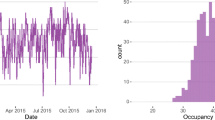Abstract
The flow of patients through geriatric hospitals has been previously described in terms of acute (short‐stay), rehabilitation (medium‐stay), and long‐stay states where the bed occupancy at a census point is modelled by a mixed exponential model using BOMPS (Bed Occupancy Modelling and Planning System). In this a patient is initially admitted to acute care. The majority of the patients are discharged within a few days into their own homes or through death. The rest are converted into medium‐stay patients where they could stay for a few months and thereafter either leave the system or move on to a long‐stay compartment where they could stay until they die. The model forecasts the average length of stay as well as the average number of patients in each state. The average length of stay in the acute compartment is artificially high if some would‐be long‐term patients are kept waiting in the short‐stay compartment until beds become available in long‐stay (residential and nursing homes). In this paper we consider the problem as a queueing system to assess the effect of blockage on the flow of patients in geriatric departments. What‐if analysis is used to allow a greater understanding of bed requirements and effective utilisation of resources.
Similar content being viewed by others
References
P. Crofts, J. Barlow and R. Edwards, A cliniqueue solution, OR Insight 10 (1997) 22-27.
H.O. Davies and R. Davies, Simulating health systems: modelling problems and software solutions, European Journal of Operational Research 87 (1995) 35-44.
H.O. Davies and R. Davies, A simulation model for planning services of renal patients in Europe, Journal of Operational Reseach Society 38 (1997) 693-700.
R. Davies, An interactive simulation in the Health Service, Journal of Operational Reseach Society 36 (1985) 597-606.
R. Davies, An assessment of models of a health system, Journal of Operational Reseach Society 36 (1985) 679-687.
R. Davies, Simulation for planning services for patients with coronary artery disease, European Journal of Operational Research 71 (1994) 323-332.
R. Davies and T. Davies, Using simulation to plan health service resources: discussion paper, Journal of the Royal Society of Medicine 79 (1986) 154-157.
DHSS, Report of a study on the respective roles of the general acute and geriatric sectors in the care of the elderly hospital patient, ISBN 0-902650-34-3, Department of Health, London, 1981.
DoH, Circular HSG(95)8, NHS responsibilities for meeting continuing health care needs, London, DoH, 1996.
M.S. Feldstein, Operational research and efficiency in the Health Service, Lancet 1 (1963) 491-493.
G.W. Harrison, Compartmental models of hospital patient occupancy patterns, in: Modelling Hospital Resource Use: a Different Approach to the Planning and Control of Health Care Systems, eds. P.H. Millard and S.I. McClean (Royal Society of Medicine, London, 1994) pp. 53-61.
G.W. Harrison and P.H. Millard, Balancing acute and long term care: the mathematics of throughput in departments of geriatric medicine, Meth. Inform. Med. 30 (1991) 221-228.
P. Horrocks, The components of a comprehensive district health service for elderly people - a personal view, Age Ageing 15 (1986) 321-342.
P.E. Hudson, V. Peel and A. Rayner, Using computer simulation to plan Accident & Emergency services, British Journal of Health Care Management 3 (1997).
V. Irvine and S.I. McClean, Stochastic models for geriatric in-patient behaviour, IMA J. Math. App. Med. Biol. 11 (1994) 207-216.
M.A. Law and W.D. Kelton, Simulation Modeling & Analysis, 2nd ed. (McGraw-Hill, 1991).
C. Lee, C. Vasilakis, D. Kearney, R. Pears and P.H. Millard, An analysis of admission, discharge and bed occupancy of stroke patients aged 65 and over in English hospitals, Health Care Management Science 1 (1998), this issue.
S.I. McClean and P.H. Millard, Patterns of length of stay after admission in geriatric medicine: an event history approach, The Statistician 42 (1993) 263-274.
S.I. McClean and P.H. Millard, A decision support system for bed-occupancy management and planning hospitals, IMA J. Math. App. Med. Biol. 12 (1995) 225-234.
P.H. Millard, Geriatric medicine: a new method of measuring bed usage and a theory for planning, MD thesis, University of London, 1989.
P.H. Millard, Throughput in a department of geriatric medicine: a problem of time, space and behaviour, Health Trends 24 (1992) 20- 24.
P.H. Millard, Current measures and their defects, in: Modelling Hospital Resource Use: a Different Approach to the Planning and Control of Health Care Systems, eds. P.H. Millard and S.I. McClean (Royal Society of Medicine, London, 1994) pp. 29-37.
J. Mitchell, K. Kafetz and B. Rossiter, Benefits of effective hospital services for elderly people, Br. Med. J. 295 (1987) 980-993.
A. Parry, An age-related service revisited, in: Go with the Flow: a Systems Approach to Healthcare Planning, eds. P.H. Millard and S.I. McClean (Royal Society of Medicine, London, 1996) pp. 127-130.
I.C. Taylor and J.G. McConnell, Patterns of admission and discharge in an acute geriatric medical ward, The Ulster Medical Journal 64 (1995) 58-63.
D.W. Vere, Assessing and allocating beds in acute medicine in East London, Br. Med. J. 287 (1983) 849-850.
S. Wyatt, The occupancy management and planning system (BOMPS), Lancet 345 (1995) 243-244.
Author information
Authors and Affiliations
Rights and permissions
About this article
Cite this article
El‐Darzi, E., Vasilakis, C., Chaussalet, T. et al. A simulation modelling approach to evaluating length of stay, occupancy, emptiness and bed blocking in a hospital geriatric department. Health Care Management Science 1, 143–149 (1998). https://doi.org/10.1023/A:1019054921219
Issue Date:
DOI: https://doi.org/10.1023/A:1019054921219




